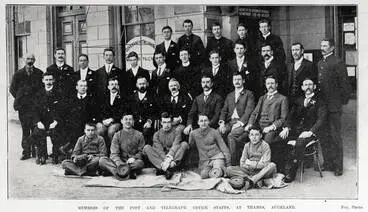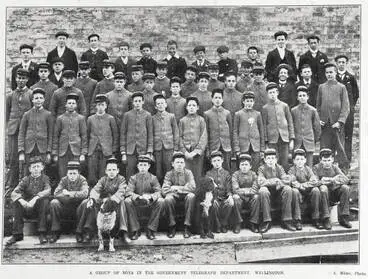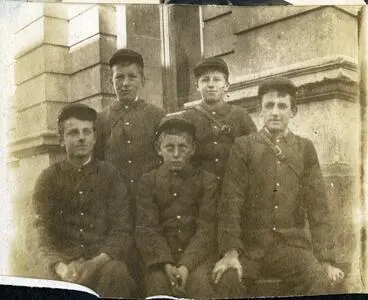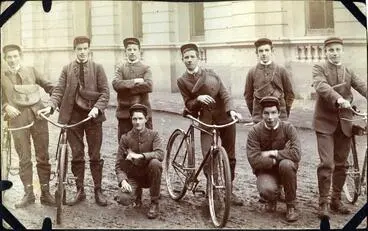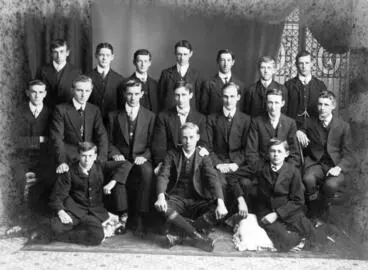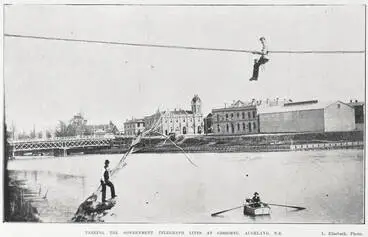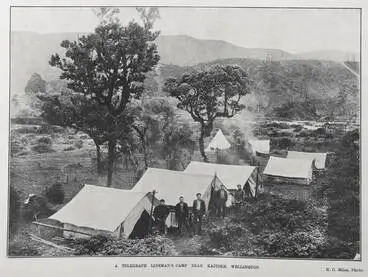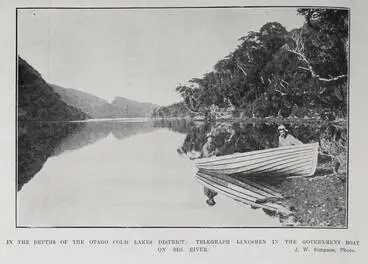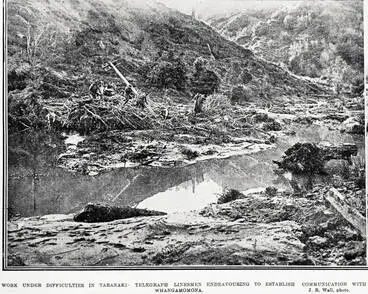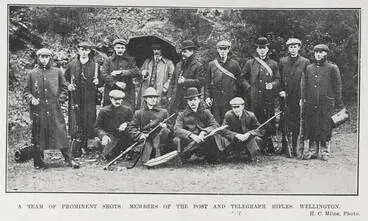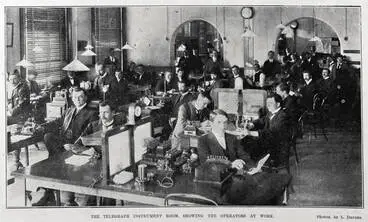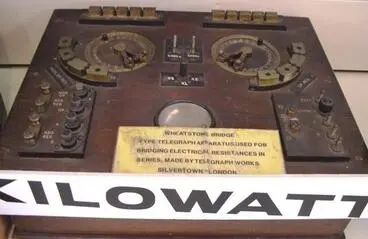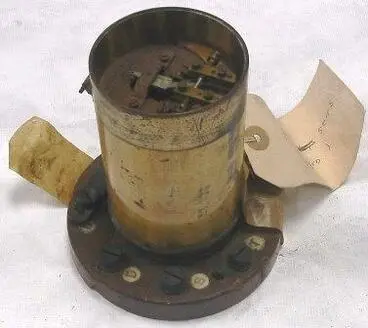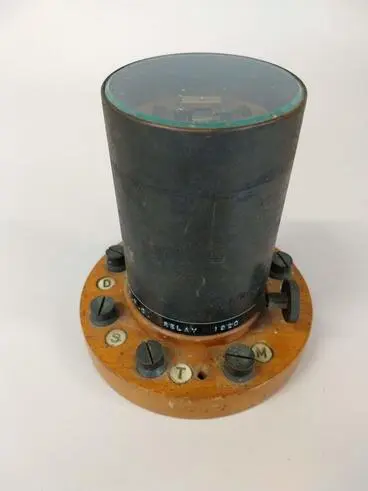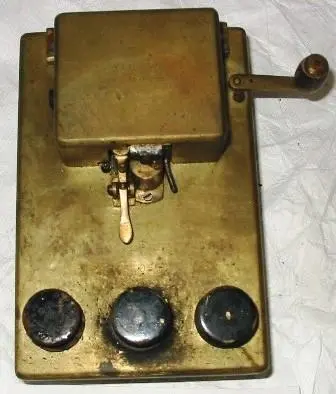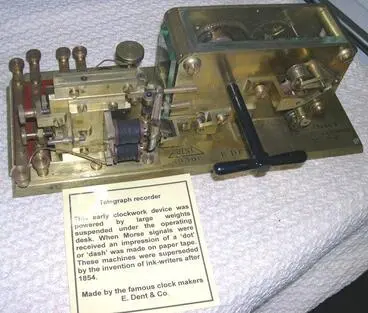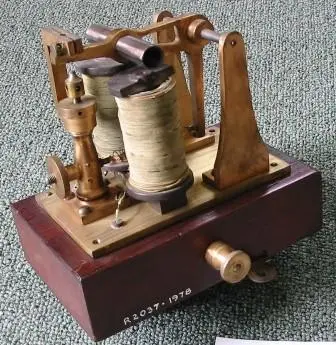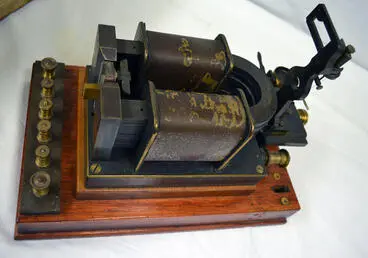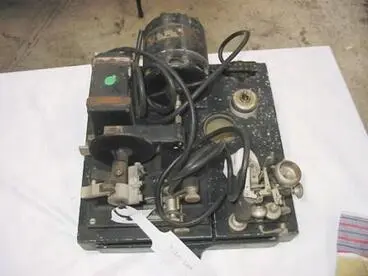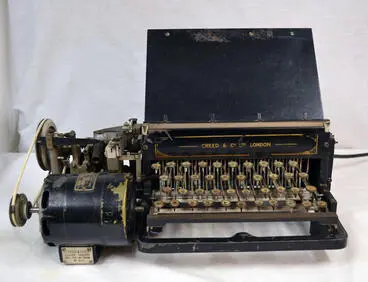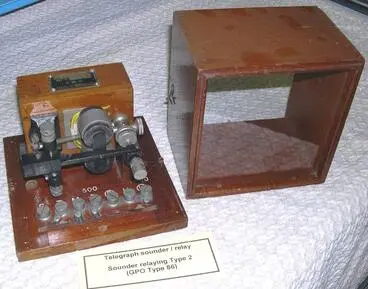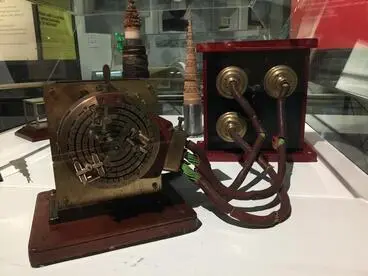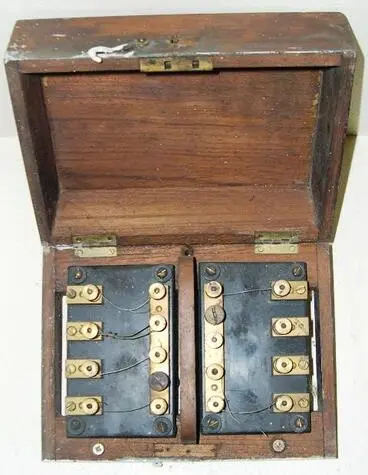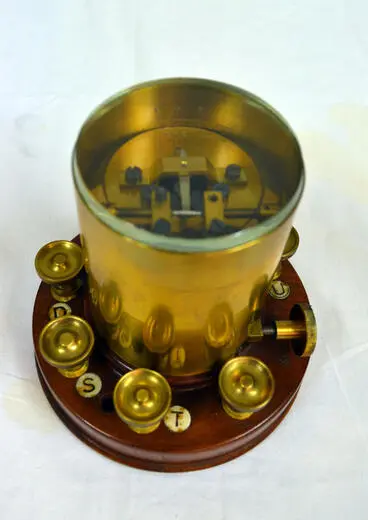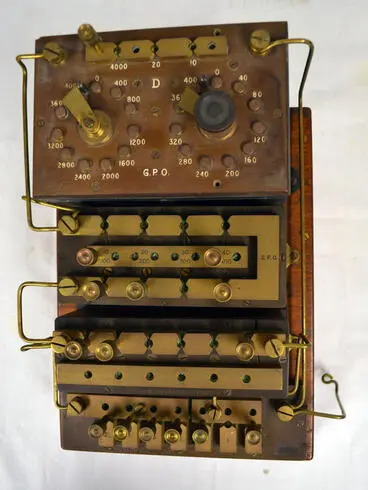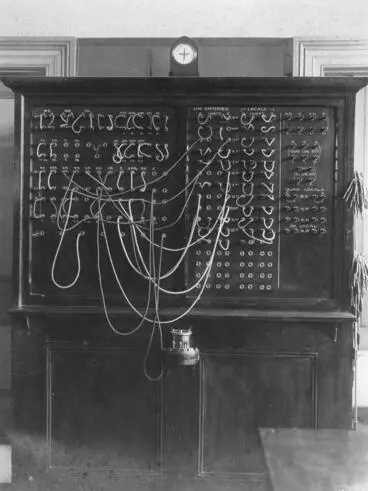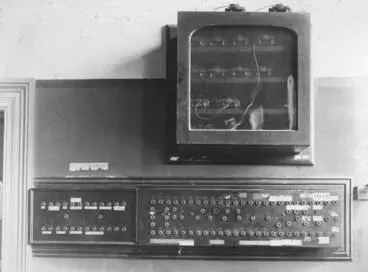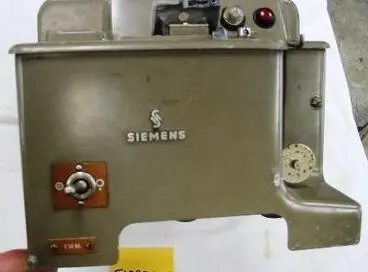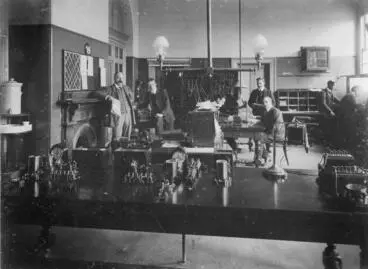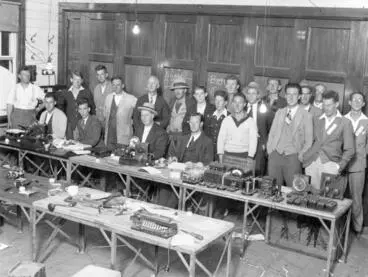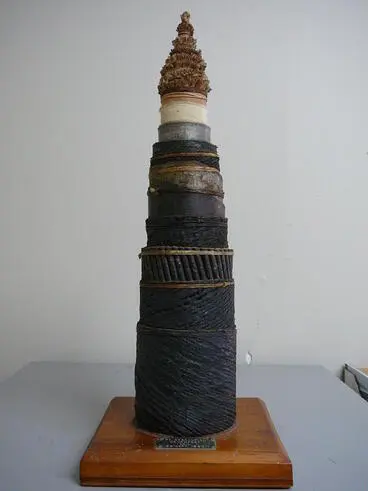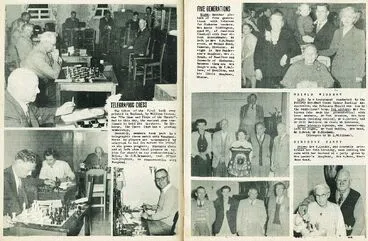Telegrams and their messages
A DigitalNZ Story by Zokoroa
Pictorial journey on the history of telegrams in NZ - the types of messages conveyed (even wedding congratulations from the Royal Corgis!); and a look behind the scenes at how telegrams were sent, including the journey of women to join the staff.
Telegram, telegraph, mail, telecommunications, communications, correspondence, celebrations, weddings, birthdays, war, post office, postal, occupations, jobs, women, women workers, female workers, discrimination, equality, gender
Have you ever seen a telegram or know of family members who received one!? Before the advent of faxing, emailing, texting, tweeting and posting on social media, telegrams were used to send a written message quickly over long distances using an electrical device known as a 'telegraph'. The earliest telegraphs, also called a 'wire', were developed in the 1830s and the NZ Post Office ceased delivering telegrams in 1987. (See: Wikipedia: Telegraphy)
Messages were handwritten or printed off by Post Office Telegraph operators
Heretaunga Players; Telegram
Upper Hutt City Library
Telegram was delivered by Post Office messengers, who often used bicycles
Esther O'Kane, 100th birthday
South Canterbury Museum
1. Receiving a telegram - its message
Telegrams were used to convey important news, conduct business transactions, and to celebrate significant events - like reaching 100 years and receiving a congratulatory telegram from the reigning British Monarch. Receiving a telegram could produce an array of feelings - from curiosity, to delight, to anxiety. Here are some of those moments captured on DigitalNZ.
WOMEN AND A TELEGRAM. (Marlborough Express, 27 September 1890)
National Library of New Zealand
Birthday wishes
Greetings for 100th birthday sent by Consul under instructions from Signor Mussolini, Prime Minister of Italy, 1933
Telegram received on occasion of Captain William J Newby's 100th birthday, 1933
Auckland Libraries
Prime Minister Walter Nash with birthday greetings for 78th birthday in 1960
Prime Minister Walter Nash in his office holding telegrams with birthday greetings for his 78th birthday
Alexander Turnbull Library
Congratulations - You've got Royal Mail!
The sending out of 100th birthday greetings was started by King George V in 1917 - the royal message, a telegram, would come from the Private Secretary. Telegrams were replaced by British Telecom in 1982 with telemessages which were dictated over the telephone or sent via telex, and printed off on paper. In 1999, a laser-printed greetings card began to be sent by Queen Elizabeth with a photo of Her Royal Majesty. The message inside reads: "I am pleased to know that you are celebrating your 100th birthday. I send my congratulations and best wishes to you on such a special occasion." (See BBC News). The oldest recipient of a message from Queen Elizabeth was a Canadian gentleman, who reached the age of 116 in December 1984 (see: Royal.uk: Anniversary messages).
Celebrating 100th birthday, 1933
A. K. Kingsford Photo, CORPORAL J. COLTHART, Maori War veteran of the Wanganui Regiment, ivho yesterday celebrated his hundredth birthday at Nelson...
National Library of New Zealand
Telegrams received included one from King Edward VIII, 1936
101 YEARS OLD.—Mm. M. A. Hills, of Onehunga, Auckland, who celebrated her 101 st birthday on Monday. She received many telegraphed messages of cong...
National Library of New Zealand
Message received from Queen Elizabeth, 2008
Bill & Alice Williams-Telegram from the Queen
Manatū Taonga, the Ministry for Culture and Heritage
Nowadays, the delivery of congratulatory messages is arranged by a team of staff at the Anniversaries Office at Buckingham Palace. You need to apply to receive a Royal message. See New Zealand Government: Congratulatory messages.
On her 100th birthday, Eva Carr of Dunedin received flowers and messages, including one from Queen Elizabeth, 2009
Turning 100
Manatū Taonga, the Ministry for Culture and Heritage
And a telegram from the Royal Corgis!
The following telegram was received from the Royal Corgis who had been invited to attend the wedding of two Jack Russell terriers: "Congratulations and best wishes on your great day. We would love to be with you on the 3rd October, but our Mummy said 'we are the wrong breed'. Our Mummy may give us a party over here if we are very good. Hope any problems are small. Cute & Fluffy, Woof woof, the Royal Corgis."
Telegram from the Royal Corgis for wedding of two dogs - Tessa and Jack
Tessa and Jack's wedding 28; a telegram from the royal corgis
Upper Hutt City Library
Weddings & anniversaries
Congratulatory telegrams were sent for wedding anniversaries: 50th (Golden), 55th (Emerald), 60th (Diamond), 65th (Blue Sapphire), 70th (Platinum) and every year thereafter. Nowadays, depending on what wedding is being celebrated, congratulatory messages will be sent from: His Majesty the King, Governor-General, Prime Minister, Minister for Seniors, local MP, and local Mayor (depending on where you live). (See New Zealand Government: Congratulatory messages)
Wedding telegrams, 1939
Mr. and Mrs. T. H. C. Caughey and the best man, Mr. H. Jackson, reading telegrams
Auckland Libraries
Diamond (60th) wedding anniversary congratulations from the King & Queen, 1937
Evening Post" Photo. Mr. and Mrs. IF. T. Grundy, of Hawker Street, Wellington, who celebrated their diamond- wedding on Saturday. Among the. congra...
National Library of New Zealand
Diamond (60th) wedding anniversary, 1937
Sir James and Lady Allen on their diamond wedding day
Auckland Libraries
Wedding messages may be sent by the Queen, Governor-General, Parliament & local Mayor. (Photo: G-G Lord Cobham, 1957)
Governor-General Lord Cobham holding a telegraph at the Government House, Wellington
Alexander Turnbull Library
Diamond wedding telegrams, some of which were from the Queen, Governor General, PM & Minister of Internal Affairs, 1963
Personal
Gisborne Photo News
Occasion thought to be a wedding anniversary, c.1975
Lydia and Sid Grant : digital image
Wairarapa Archive
Conveying news about events
Congratulatory telegram on opening of Lyttelton Tunnel, 1867
Early telegrams
Manatū Taonga, the Ministry for Culture and Heritage
Telegram from Native Minister Donald McLean, 1872
Native Minister - Outward telegrams
Alexander Turnbull Library
Telegraph was used to coordinate the observation of the transit of Venus by visiting American scientists during 1874-75
Transit of Venus observation station
Manatū Taonga, the Ministry for Culture and Heritage
Telegram about arrangements for the Custom Houses in NZ on day of funeral of King Edward VII, 1910
Telegram Regarding funeral of King Edward VII (1910)
Archives New Zealand Te Rua Mahara o te Kāwanatanga
Waihi Strike, 1912
Waihi Strike Telegrams from Police Commissioner John Cullen, 9 November 1912 (1 of 5)
Archives New Zealand Te Rua Mahara o te Kāwanatanga
White Island eruption, 1914
Telegram re: White Island Eruption 1914
Archives New Zealand Te Rua Mahara o te Kāwanatanga
Hawkes Bay earthquake - telegram from King George V, 1931
1931 Hawke's Bay Earthquake - Telegram from King George V
Archives New Zealand Te Rua Mahara o te Kāwanatanga
Telegram notifying that "Lolita" was banned in New Zealand by the Minister of Customs in 1959
Telegram Announcing prohibition of the novel 'Lolita'
Archives New Zealand Te Rua Mahara o te Kāwanatanga
Telegram from the Governor-General wishing Princess Elizabeth a happy birthday (17 years) and her reply, 1943
Princess Elizabeth's birthday, 1943
Archives New Zealand Te Rua Mahara o te Kāwanatanga
Encoded telegram announcing birth of Prince Charles, 1948
Telegram Announcing the Birth of Prince Charles, 1948
Archives New Zealand Te Rua Mahara o te Kāwanatanga
Messages during times of war
The telegraph service was used by military personnel and the Government to communicate war news more quickly. Summaries were posted in outlying Post and Telegraph (P & T) offices.
1866: Austro-Prussian War
National Library of New Zealand
1900: Military kites receiving messages by wireless telegraphy in South Africa
Military kites at work receiving messages by wireless telegraphy
Auckland Libraries
World War I
Telegram announcing outbreak of war against Germany, 1914
Archives New Zealand Te Rua Mahara o te Kāwanatanga
Post & Telegraph staff joined the armed forces in combatant or communication roles
Members of the World War I Post & Telegraph Guard, Cable Bay, Nelson
Alexander Turnbull Library
1915: Wireless operator's quarters
The wireless operator's quarters. From the album: Photograph album of Major J.M. Rose, 1st NZEF
Museum of New Zealand Te Papa Tongarewa
1916: Post and Telegraph Office at Featherston Camp
Featherston Camp Post Office : digital image
Wairarapa Archive
Christmas telegram sent by a NZ soldier in Egypt to family in 1916
Christmas telegram from Egypt
Manatū Taonga, the Ministry for Culture and Heritage
Applications invited from young women aged 18-21 and youths to be trained to fill vacancies, May 1916
YOUTHS AND YOUNG WOMEN AS TELEGRAPHISTS. (Colonist, 23 May 1916)
National Library of New Zealand
By 1918 there were 850 female 'temporaries'. Initially paid £40 per annum, whilst rural location was £40 & £28 lodgings.
GIRL OPERATORS. (Northern Advocate, 12 June 1916)
National Library of New Zealand
Example of telegram sent to families of soldiers who were killed, wounded or became ill during WWI
Telegram
Museum of New Zealand Te Papa Tongarewa
Urgent telegram to Governor-General, Lord Liverpool, that Armistice with Germany signed, 1918
Armistice signed telegram
Manatū Taonga, the Ministry for Culture and Heritage
World War II
Instruction to report to squadron headquarters immediately for mobilisation, 1939
MTG Hawke's Bay
Telegram to husband serving overseas advising of birth of son, 1940
Telegram, Clara Quilter to Thomas Quilter
Mataura Museum
Writing telegrams to friends and relatives on return from serving overseas, 1943
New Zealand’s fighting soldiers return from North Africa on extended leave
Auckland Libraries
Soldiers sending telegrams in Auckland region, 21 July 1943
New Zealand’s fighting soldiers return from North Africa on extended leave
Auckland Libraries
Cynthia Bell describes sending out casualty telegrams
Manatū Taonga, the Ministry for Culture and Heritage
Woman driving a post and telegraph truck during World War II
Alexander Turnbull Library
2 NZEF Christmas Greetings telegram 1944
Auckland Libraries
3 NZ General Hospital Christmas Greetings telegram 1944
Auckland Libraries
Business transactions
In July 1896, it took 2 hours to transmit the Financial Statement (14,280 words) & 20 mins to transcribe from the tape
SMART TELEGRAPHISTS. (Wanganui Herald, 16 July 1896)
National Library of New Zealand
Telegram to Auckland Customs regarding Snake Charmer Cleopatra (1909)
Archives New Zealand Te Rua Mahara o te Kāwanatanga
Library sale - asking if Museum's Library will take Jardine's series of forty volumes, if not will put it up in the sale
Museum of New Zealand Te Papa Tongarewa
Congratulations on a job well done!
Congratulatory telegrams on Cabinet appointment, 1912
Second In Command In The New Cabinet
Auckland Libraries
Captain Batten reading telegram with congratulatons for Jean Batten's progress on her England - NZ flight, 1935
Captain Frederick Harold Batten and an unidentified dental nurse reading a telegram of congratulations for Jean Batten's progress on her England - ...
MOTAT
Jean Batten reading telegrams and cablegrams of congratulations at her hotel in Sydney, 1936
Reading telegrams and cablegrams of congratulations at her hotel in Sydney
Auckland Libraries
Congratulatory telegrams on Mr Jobson's retirement from Post and Telegraph Dept from former pupils, 1955
Mr and Mrs Jobson with telegrams
Alexander Turnbull Library
Mrs Nash with telegrams in 1957 - the year her husband Walter became Prime Minister at the age of 75
Mrs Walter Nash, with telegrams
Alexander Turnbull Library
Newly elected Prime Minister Bill Rowling with some of the telegrams sent to congratulate him, 1974
Bill Rowling with telegrams
Alexander Turnbull Library
Long telegram conveying the thanks of 1,657 Hastings citizens to police following Springbok tour, 1981
Police Senior Sergeant, Owen Dance, holding a telegram
Alexander Turnbull Library
2. How telegrams were sent and received
Customer paid by the word to have a message telegraphed by staff to another Telegraph Office
Telegraph series, 1953. W.N. Feature.
Auckland War Memorial Museum Tāmaki Paenga Hira
Operators used plain text or Morse code to transmit and receive an electrical signal over a wire laid between stations
Telegraph series, 1953. W.N. Feature
Auckland War Memorial Museum Tāmaki Paenga Hira
Message was written or printed onto paper (telegram) and hand-deiivered by Telegraph Office messengers to the addressee
Post Office Telegraph Messengers
Nelson Provincial Museum
Telegrams were sent by text or translated into Morse code
At the receiver's end they were written or typed out on telegrams, and delivered
MOTAT
3. How much to send a Telegram?
1865: Tariff of charges
National Library of New Zealand
1870: Within NZ, telegram cost 1 shilling for 10 words
Telegram to London cost 15 shillings per word, & 1s 6d to Australia (See Te Ara)
Alexander Turnbull Library
1896: Within NZ, cost reduced to 6d for 10 words, with slow or urgent half & double rates
Post-master General Joseph Ward (1891-1912) also introduced penny postage for letters in 1901
Manatū Taonga, the Ministry for Culture and Heritage
1911: With the advent of wireless telegrams, ordinary telegrams cost 10d per word
National Library of New Zealand
4. Beginnings: Setting up national network
Local Posts Act of 1856 allowed Provincial Governments to establish post offices
30 The Local Posts Act 1856
The University of Auckland Library
Post Office Act of 1858 re-organised postal services under a Postmaster-General
15 New Zealand Post Office Act 1858
The University of Auckland Library
Electric Telegraph Act of 1865 created the Telegraph Office to erect lines & telegraph offices
37 Electric Telegraph Act 1865
The University of Auckland Library
Stage 1: Lyttelton - Christchurch - Dunedin - Invercargill (1862)
In 1862, NZ's first telegraph line was set up between Lyttelton and Christchurch by the Canterbury provincial government. It was then extended from Invercargill, via Dunedin and Christchurch, to the Hurunui river in North Canterbury.
In 1862, NZ's first telegraph line was set up between Lyttelton & Christchurch
National Library of New Zealand
Former Lyttelton telegraph office building can be seen on the right
Christchurch City Libraries
Then line was extended to Dunedin and Invercargill
National Library of New Zealand
Stage 2: Private and Military lines, & Electric Telegraph Office (1865)
The Canterbury line led to the establishment of private and military networks. The first line in the North Island was a military line from Auckland to Pokeno that was later extended to the Waikato (Cambridge and Te Awamutu) in 1863. To rationalise this development of telegraph lines throughout NZ, the Electric Telegraph Department (created under the Electric Telegraph Act 1865) took responsibility for the acquiring of land, the erecting of telegraph lines and the opening of telegraph offices. Gradually the private and military networks came under centralised control with only 19 of the 214 telegraph stations still operating independently by 1879. (See An encyclopaedia of New Zealand 1966: Post Office - Inland communications
First North Island line was a military line from Auckland to the Waikato (1863)
Waikato Frontier - Showing redoubts, blockhouses etc, telegraph lines - scale 2 miles:1 inch - W. Bogle (no date)
Archives New Zealand Te Rua Mahara o te Kāwanatanga
Expanding the Auckland telegraph line 1863-1864
ELECTRIC TELEGRAPH IN AUCKLAND (Daily Southern Cross, 11 October 1864)
National Library of New Zealand
Stage 3: Cook Strait Cable, 1866-
In 1866 the seabed link across Cook Strait was successfully laid on the second attempt between Lyall Bay in Wellington and White's Bay in Marlborough. However, "[t]he isolated and often stormy situation of the White's Bay Cable Station made it an unpopular posting. The staff and equipment were moved to Blenheim in 1873, and the telegraph station finally closed in 1896, after a direct link had been established between Wellington and Christchurch." (See The Prow: Telegraph made world of difference)
1866: Telegraph cable laid across Cook Strait seabed
1866: Telegraph cable laid across Cook Strait between Lyall Bay in Wellington & White's Bay in Marlborough
Manatū Taonga, the Ministry for Culture and Heritage
Telegraph network extended from Napier to Bluff
Auckland Libraries
Cook Strait repairs and upgrades over the decades:
The Cook Strait's insulated copper cable needed repairs over the years. The Telegraph Construction and Maintenance Company laid further cables in 1876, using the cable steamers Hibernia and Edinburgh. On 11 February 1880 another Cook Strait cable was laid from Wanganui to Wakapuaka by the cable steamer Kangaroo. New power cables were laid over the decades. For a summary, see: Keith Lewis, 'Engineering on the sea floor - Submarine cables', Te Ara - the Encyclopedia of New Zealand, http://www.TeAra.govt.nz/en/engineering-on-the-sea-floor/page-2
1926: Laying new Cook Strait cable
Laying The New Inter -Island Telephone Cable Across Cook Strait
Auckland Libraries
1929: Cable repairs using the ship Iris
Maintaining cable communication across Cook Strait: snapshots from the repair ship Iris
Auckland Libraries
1929: Repairs to Cook Strait cable
Repairs to Cook Strait cable: landing a new portion near Wellington
Auckland Libraries
1936: Laying the new Cook Strait cable at Wellington
Laying the new shore end of the Cook Strait telegraph and telephone cable: operations at Lyall Bay, Wellington
Auckland Libraries
1937: Echo-sounder used to graph depth of Cook Strait waters to select route for new co-axial cable
This is a reproduction of an automatically-recorded graph of soundings in Cook Strait, made with an "echo-sounder" in the, course of- the survey of...
National Library of New Zealand
1964: New power cable being laid across Cook Strait
Cook Strait power cables being laid from Oteranga Bay, Wellington
Alexander Turnbull Library
1991: Three new power cables and two new fibre-optic cables were laid along the Cook Strait sea floor
Upgrading cables
Manatū Taonga, the Ministry for Culture and Heritage
Stage 4: Coromandel Ranges & liaison with iwi: 1872
The Wellington-Auckland line was completed in 1872. The last stage of the national network was the telegraph line across the Coromandel Ranges from Hikutaiā to Whangamatā. Following the New Zealand wars of the 1860s, many Māori had objected to the construction of roads, railways and telegraph lines across their land, as they believed this would encourage the spread of settlers. Chief Taipari offered his assistance to obtain the consent of hapū living along the proposed telegraph route. (See: Paul Monin, 'Hauraki–Coromandel region - Transport and communications', Te Ara - the Encyclopedia of New Zealand, http://www.TeAra.govt.nz/en/document/30992/old-wires-track-report-on-telegraph-line-progress)
New Zealand’s telegraph network, 1868
Manatū Taonga, the Ministry for Culture and Heritage
A newspaper report of 17 June 1872 on the liaison with hapū in the Coromandel area
Old Wires Track: report on telegraph line progress
Manatū Taonga, the Ministry for Culture and Heritage
Stage 5: First Trans-Tasman (Australia - Nelson) telegraph cable (1876)
In 1876, a trans-Tasman telegraph cable enabled direct communication by NZ with Australia and on to Asia, Europe and Britain. The Eastern Extension, Australasia and China Telegraph Company were contracted to establish and operate the cable, which was manufactured and installed by British company Telcon. As stated in Te Ara: "In February 1876 the Eastern Extension Company laid cable between La Perouse, New South Wales and Wakapuaka near Nelson. The New South Wales and New Zealand governments subsidised the cost. Connections overland via Adelaide and Darwin, and undersea via Java and Suez, allowed telegraphic contact with London the same year." (Source: A. C. Wilson, 'Telecommunications', Te Ara - the Encyclopedia of New Zealand, http://www.TeAra.govt.nz/en/telecommunications/print) A cable station was established at Schroder’s Mistake which was renamed Cable Bay.
1871: Map/plan of constructed and proposed telegraph lines between Asia and Europe
Map of telegraph lines constructed & proposed between Europe and Australia
State Library of Victoria
1873: AJHR: Agreement for telegraph cable to be laid between NZ and New South Wales, & between Queensland and Singapore
ELECTRIC TELEGRAPH CABLES.
National Library of New Zealand
1876: Trans-Tasman cable laid from NSW to Wakapuaka (Cable Bay), near Nelson
LATEST TELEGRAMS. (Grey River Argus, 10 February 1876)
National Library of New Zealand
1876: The telegraph cable being laid at La Perouse, NSW by the ship Hibernia
Landing of the New Zealand to Sydney telegraph cable at La Perouse in 1876
Australian National Maritime Museum
The New Zealand Telegraph Department employed and trained the first telecommunications operators who used Morse keys to send and decode messages. The new telegraph service began operating on 31 Feb 1876 and the following was reported in the Evening Mail the next day. "Messages arrived in code and the Press agent divided the news into grades A., B. or C. and the messages, so graded, were returned to the Telegraph Office Staff with instructions as to their overland destinations. All land lines were operated by Morse key." (Source: NZETC: Cable and Delware Bays)
1876: The telegraph cable came ashore at Cable Bay, near Nelson. Station's call sign was WAK "waka" (meaning canoe).
Where The Cable News From The Outside World First Reaches New Zealand
Auckland Libraries
The number of staff grew over the next decade: "By 1888 there were 14 staff, including a superintendant, cable and telegraph men. A press man had the job of ‘filling out’ the international press briefs and sending them on to newspapers." (See The Prow: Telegraph made world of difference) In 1890, the Eastern Extension installed a second cable at Cable Bay using the ship Scotia, by which time 17 staff and their families lived at Cable Bay. A major section of the first cable was renewed in 1895 by the cable steamer Sherard Osborn.
Operating room at Cable Bay, Wakapuaka, Nelson (1902)
The operations room at the Wakapuaka cable station
Auckland Libraries
5. Telegrams supplemented by telephones: 1879 -
The first telephone office was opened at Port Chalmers in 1879 with the first link to Portobello to enable shipping information to be relayed more quickly to Dunedin. Telephones began to be used "to supplement the telegraph in small towns which lacked the finance to employ Morse operators". (See: Nethistory.co.nz: Connecting the Clouds - the Internet in New Zealand)
March 1879: First telephone office opened at Port Chalmers with link to Portobello
National Library of New Zealand
6. New Zealand Post and Telegraph Department: 1881
In 1881, the Telegraph Department was replaced by The New Zealand Post and Telegraph Department. For a snapshot of further details, see the timeline on NetHistory (ibid).
1881: Post and Telegraph Department was formed by merging the electric telegraph service with the Postal Department
Ophir: Post and Telegraph Office (c.1886) (1)
Manatū Taonga, the Ministry for Culture and Heritage
7. Extending international connections: 1900 -
Stage 1: Vancouver to Northland (1902):
In 1902 a cable was laid between Canada and NZ via Norfolk Island, Suva (Fiji), and Fanning Island (Kiribati). "With the completion of the Pacific cable, the telegraph finally 'girdled the earth'." (Source: Museums Victoria Collections: Australia & the Global Telegraph Network, 1854-1902).
Vancouver to Doubtless Bay, Northland, 1902
In 1902, the cable from Vancouver to Norfolk Island was extended to Doubtless Bay by cable steamer
Auckland Libraries
Official and visitors on board the ship at the landing of the cable on 24 March 1902
Officials and visitors on board the C S Anglia at the landing of the Pacific Cable, Doubtless Bay, Northland, 24 March, 1902
Auckland Libraries
1902-1912: Pacific Cable Station operated at Doubtless Bay, Northland. All messages were in Morse code.
The Pacific Cable station, Doubtless Bay, Northland
Auckland Libraries
Stage 2: Sydney - Auckland (1912):
The Pacific cable laid from from Bondi Beach to Auckland in 1912 also connected NZ with the rest of the world via Australia and Vancouver.
c.15 Nov 1912: Laying 1225 nautical mile Pacific cable at Bondi Beach to Auckland with the ship Silvertown offshore
Laying the Pacific Cable from Bondi, Sydney to Auckland, New Zealand
Australian National Maritime Museum
HMCS Iris diverted the cable at Doubtless Bay (Northland) to Auckland
The dynamometer which controls the speed with which the cable is paid out
Auckland Libraries
Deep-sea sounding apparatus used in laying submarine telegraph cables
The deep-sea sounding apparatus
Auckland Libraries
4 Dec 1912: Four photographs showing the submarine telegraph cable from Doubtless Bay being brought ashore at Takapuna
From Auckland to Doubtless Bay - landing a new submarine cable at Takapuna
Auckland Libraries
Stage 3: Cable Bay re-routed to Titahi Bay (1917) & Muriwai Beach (1932):
Sydney cable re-routed in 1917 & 1932
Link from Le Perouse re-routed from Cable Bay to Titahi Bay (Porirua, Wellington) in 1917, & to Muriwai Beach in 1932
Auckland Libraries
Stage 4: Pacific cable extended from Fiji - Auckland (1923):
1923: Pacific Cable extended from Suva, Fiji to Auckland, bypassing Norfolk Island
Cable ship Stephan lays new Direct Cable from Suva to Auckland
Auckland Libraries
Suva - Auckland cable laid by the Telegraph Construction and Maintenance Company, using the ship Stephan
Work of A Modern Cable Strainer
Auckland Libraries
Landing the cable at Takapuna, Auckland
First Step in Final Section of Auckland-Suva Cable Duplication
Auckland Libraries
Stage 5: Commonwealth Telecommunications Agreement (1945):
At the Commonwealth Telecommunications Conference held in London in 1945, the Commonwealth's external telecommunications systems were brought under Government control. In accordance with the Commonwealth Telegraphs Agreement 1948, the New Zealand Post Office purchased the assets in New Zealand of Cable and Wireless Ltd., the private company previously controlling the cable services, and took over the operation of both the internal and overseas cable services.
1945: External communications to be under Government control
New Zealand Post Office purchased the assets in New Zealand of Cable and Wireless Ltd (a private company)
National Library of New Zealand
Stage 6: COMPAC (Commonwealth Pacific Cable) (1962-63):
The following four-staged laying of cables was part of a Commonwealth round-the-world cable project:
(1) April-June 1962: Sydney - Muriwai Beach (west of Auckland): A new submarine cable with a capacity of 80 telephone channels was laid between Australia and NZ. The cable steamer Retriever laid the shore ends at Muriwai Beach in April, followed by the Monarch laying the 1273 nm (nautical mile) cable and 50 repeaters during June. The COMPAC cable replaced the first Trans-Tasman cables 1 and 2, of which the remnants at the three landing sites (Cable Bay, Titahi Bay and Muriwai Beach) were added to the IPENZ Engineering Heritage Register on 26 August 2014. (See: Engineering New Zealand: Heritage Register)
(2) October 1962, Auckland - Suva, Fiji: This section was laid by the same vessels using a 1260 nm with 50 repeaters.
1962: COMPAC cable from Australia laid at Muriwai Beach
Cable was extended to Fiji in Oct 1962, & to Vancouver via Hawaii in Dec 1963, where it linked with trans-Atlantic cable
Auckland Libraries
(3) Dec 1963: Suva, Fiji via Hawaii, to Vancouver - Britain. At Vancouver the link then went across Canada by microwave to Montreal. The Commonwealth cable fed into the US network at Hawaii and into the European network at London via the trans-Atlantic telephone cables (opened in Dec 1961), which provided circuits for telephone, telegraph, and telex communication.
(4) 1967: New Zealand to Southeast Asia. The section linking NZ to South-East Asia from Sydney to Singapore via Cairns, Madang, Guam, Hong Kong and Kota Kinabalu, was opened on 30 March 1967.
See:
A. C. Wilson, 'Telecommunications - Phones, faxes and satellites', Te Ara - the Encyclopedia of New Zealand, http://www.TeAra.govt.nz/en/photograph/22021/south-east-asia-commonwealth-cable
1967: SEACOM (South-East Asia) cable to Singapore
Manatū Taonga, the Ministry for Culture and Heritage
Stage 7: TASMAN cable from Sydney to Auckland (1976):
This was a joint venture between the NZPO and OTC, Australia. The cable, which was 1258 nm cable with 155 repeaters manufactured by Standard Telephones and Cables Ltd., was laid by the cable steamer Mercury.
Stage 8: ANZCAN laid to replace COMPAC (1983-84):
The cable followed the same route as the COMPAC cable with the addition of a landing at Norfolk Island. HMNZS Monowai surveyed the route and cable steamer Retriever undertook the rerouting of part of the Fiji - Auckland COMPAC cable. Cable steamer Mercury laid the Norfolk Island - Auckland section (739 nm) and the shore ends at Auckland. Cable and repeaters were manufactured by Fujitsu. (Source: Atlantic cable website)
9. Setting up telegraph stations
A telegraph office was established in Picton in 1865. The number of telegraph stations increased from nine in 1865, to 145 stations in 1890, to 300 stations in 1910. (See: Te Ara: Telecommunications) You can find several photographs of Post and Telegraph buildings in towns and cities on DigitalNZ.
Plan of building built in 1865 at Lyttelton
Electric Telegraph Office, Lyttelton
Archives New Zealand Te Rua Mahara o te Kāwanatanga
In 1881, the telegraph service joined the Postal Department to become the Post and Telegraph Department (P & T), which became known as the ‘Post Office’ after 1959. (See Te Ara: Telecommunications).
TELEGRAPH PROGRESS. (Otago Daily Times 22-7-1909)
National Library of New Zealand
Timaru Post Office showing the original tower and timeball, circa 1893
[Timaru Post Office with timeball]
South Canterbury Museum
1890s: Whangarei Post and Telegram office
[Whangarei Post and Telegraph Office]
Auckland War Memorial Museum Tāmaki Paenga Hira
1904: Hamilton
Post and Telegraph Office, Hamilton, Waikato, New Zealand
Museum of New Zealand Te Papa Tongarewa
10. Wireless telegraph: 1903 -
The Wireless Telegraphy Act was passed on 26 September, 1903, which was a world first - a year ahead of the UK and two years ahead of Australia and Canada. The Act protected the Government’s investment in the new ‘wireline’ telephone and telegraph networks and allowed it to manage radio spectrum to prevent interference.
1902: James L. Passmore (aged 16) thought to have built first wireless set in South Island and possibly NZ
Radio set
Toitū Otago Settlers Museum
First wireless set in NZ: 1902
In 1902 in Dunedin, teenager James L. Passmore (aged 16) built what some have claimed to be the first wireless set in the South Island and possibly NZ from instructions in a magazine. "With this wireless set he experimented with transmitting messages in Morse Code. His first communications were over a distance of 100-200 metres. On 3 June 1903, he sent a message 10 kilometres from Flagstaff to Outram. The following year he received a message from 22 kilometres away, from the warship HMS Powerful." (Source: eHive: Radio set)
1899: Background to wireless telegraphy being developed overseas & Marconi's successful trials
WIRELESS TELEGRAPHY. (Star, 12 August 1899)
National Library of New Zealand
1903: Wireless Telegraphy Act was passed on 26 September
11 Wireless Telegraphy Act 1903
The University of Auckland Library
1908: NZ received wireless messages from Reuter's Telegraph Co. relayed through US naval storeships
WIRELESS TELEGRAPHY. (Taranaki Daily News 10-8-1908)
National Library of New Zealand
1908: Rawson Stark, Stanton Hicks, & Cyril Brandon (aged 16-17) set up 3 transmission stations in Dunedin
WIRELESS TELEGRAPHY IN NEW ZEALAND: THE THREE DUNEDIN BOYS WHO HAVE SUCCESSFULLY ESTABLISHED MARCONI'S WONDERFUL SYSTEM
Auckland Libraries
YOUNG MARCONIS. (Feilding Star, 11 September 1908)
National Library of New Zealand
Wellington Station
June 1912: Erecting the mast at Tinakori, Wellington
Auckland Libraries
With introductiom of wireless, messages were transmitted as signals by radio waves using Morse code
WIRELESS TELEGRAPHY IN NEW ZEALAND: INTERIOR OF RAVENSBOURNE STATIO, ONE OF THOSE FITTED UP BY THE THREE DUNEDIN BOYS
Auckland Libraries
1912: Building completed for wireless station at Tinakori
Government radio telegraph station, Tinakori Hill, Wellington
Alexander Turnbull Library
5kW short wave wireless transmitter by Amalgamated Wireless, installed at Tinakori
Trans-Tasman Radiophone Service
Hocken Collections - Uare Taoka o Hākena, University of Otago
Awanui Station in Far North
Dec 1911: Making a start on the road to the proposed Awanui Station, Kaitaia
Auckland Libraries
April 1912: Building the foundations of the Awanui Station, Kaitaia
The Most Northerly Of The Dominion's High-Power Wireless Telegraphy Stations
Auckland Libraries
Dec 1913: The new high-powered (30 kw) station at Awanui commenced operation
Radio station, Awanui
Alexander Turnbull Library
Military use
1926: Training army signallers in using wireless portable sets
Auckland Libraries
1938: Aerial base fitting for army wireless vans exhibited at Trentham Camp
Evening Post" Photo, A general view of the telegraph operating room at the Wellington General Post Office, through ivhich the messages relating to ...
National Library of New Zealand
1940: Naval training in wireless telegraphy
Training in wireless telegraphy, HMS Philomel, 1940
Victoria University of Wellington
11. Telegraphy Staffing
Telegraphist Operators pre-1900:
1893: operating room of the Telegraph Department, Auckland Region
Operating room, Wellington Telegraph Office
Auckland Libraries
1899: Staff of the Post and Telegraph Office, Oamaru
Post and Telegraph staff
Waitaki District Council
Journey of women to join men as telegraphists:
1901: Group portrait of the Napier Telegraphic staff - women and men (note the uniforms)
The Napier Telegraphic Staff
Auckland Libraries
Aug 1873: Government announces that women telephonists are to be appointed & trained in Wellington
The Nelson Evening Mail. WEDNESDAY, AUGUST 26, 1873. (Nelson Evening Mail, 27 August 1873)
National Library of New Zealand
Sept 1873: Letter opposing women as cheaper labour & "our frail sex will be found wanting in keeping the secrets"
FEMININE TELEGRAPHISTS. (Evening Post, 11 September 1873)
National Library of New Zealand
By Oct 1878, there were 22 women telegraphists in Auckland, Nelson, Canterbury & Dunedin
FEMININE TELEGRAPHISTS. (Manawatu Herald, 15 October 1878)
National Library of New Zealand
Nov 1878: Females not to be replaced with others "as close confinement during the day is very detrimental to the health"
FEMALE TELEGRAPHISTS. (Manawatu Herald, 15 November 1878)
National Library of New Zealand
Letter to Editor arguing for reintroduction of female telegraphists, Aug 1881
FEMALE TELEGRAPHISTS. (Evening Post, 01 August 1881)
National Library of New Zealand
1906: Staff at Palmerston North - women and men (note the uniforms)
THE STAFF OF THE POST AND TELEGRAPH OFFICE AT PALMERSTON NORTH, WELLINGTON, NEW ZEALAND
Auckland Libraries
Role of telegraphists since 1900:
1902: Despatch room of Telegraph office
DESPATCH ROOM OF THE TELEGRAPH OFFICE. Clerk in charge W Houston, assistant despatch clerks, R. T. Hutcheson and L. H. M'Dermott. (Photos by Gny.>...
National Library of New Zealand
1908: Post and Telegraphic staff at Palmerston North
PALMERSTON NORTH POST AND TELEGRAPH OFFICE STAFF. (Otago Witness, 09 December 1908)
National Library of New Zealand
c.1910: Counters and staff at Oamaru
Counters and staff, Post and Telegraph Department, Oamaru Post Office
Waitaki District Council
1918: Staff of the Post and Telegraph Office, Oamaru
Telegraph Gallery, Oamaru
Waitaki District Council
1930: Staff of the telegraph branch of the new Chief Post Office, Napier. (Names written under each portrait)
New Chief Post Office, Telegraph Branch
MTG Hawke's Bay
1946: Telegraph operator at Point Air Radio Station, Howick, Auckland
Telegraph Operator B V Richards, sending a telegraph, Musick Point Air Radio Station, Howick, Auckland
Alexander Turnbull Library
1953: Staff receiving telegrams in Post Office
Telegraph series, 1953. W.N. Feature.
Auckland War Memorial Museum Tāmaki Paenga Hira
1953: Women wearing headphones and voice receivers, receiving telegrams, sitting in front of Imperial manual typewriters
Telegraph series, 1953. W.N. Feature.
Auckland War Memorial Museum Tāmaki Paenga Hira
1953: Delivery shutes or shuttles being operated by staff
Telegraph series, 1953. W.N. Feature.
Auckland War Memorial Museum Tāmaki Paenga Hira
1953: Sorting cables or telegrams into pigeon holes
Telegraph series, 1953. W.N. Feature.
Auckland War Memorial Museum Tāmaki Paenga Hira
Staff training in telegraphy:
Trainiing options over the years have included courses held at Trentham; correspondence courses in telegraphy and telephony each year, and engineering officers studying physics at Victoria University College in Wellington. (See NZHistory)
1930s: Notes by Johnson's Wireless College on cable routes
Supplementary notes on cable routes. Radio telegrams (to be read in conjunction with Handbook)
MOTAT
1938: Radio telegraph operator's examination
Radio operator's examinations taken by Leslie Birch
MOTAT
1941: Women being trained in wireless telegraphy
Women trained in wireless telegraphy
Auckland Libraries
1942: Training programme held at Trentham
Work at Wellington training schools of Post and Telegraph Department: trainees drawn from all parts of New Zealand
Auckland Libraries
1955: Staff training at Post and Telegraph Dpt school at Trentham
Typists at Post and Telegraph Department school at Trentham
Alexander Turnbull Library
1955: Staff being trained at Trentham
Training of Post and Telegraph Department staff at Trentham with model of telephone pole
Alexander Turnbull Library
c1960s: New Zealand Post Office Correspondence School textbook
Study course for controlling officers examination : technical paper : transmission
MOTAT
Post Office Training College, Heretaunga
Post Office Training College, Heretaunga; residential section.
Upper Hutt City Library
Messengers:
Telegraph messengers often began working for the Post Office on leaving school:
"Telegram delivery ‘lads’ (the school-leaving age was 14, sometimes younger) were instructed not to scribble on walls, ride their bicycles recklessly, or speak to customers in an ‘improper manner’. From 1911 they were also required to join the Post and Telegraph Corps and undertake at least an hour of character-building military drill each week." (Source: NZ History)
Telegraph messengers often began working for the Post Office as soon as they left school, aged 14
Telegraph Messengers
Manatū Taonga, the Ministry for Culture and Heritage
c.1877-1915: Men and boys (with bicycles nearby) outside the Mataura Post Office & Telegraph building
Photograph [Men and Boys outside Mataura Post Office]
Mataura Museum
1903: Telegraph messengers
O'Leary, Joyce, active 2000: Post office telegraph runners, Wellington, 1903
Alexander Turnbull Library
1903: Post and Telegraph staff, including messengers, at Thames
Members of the Post and Telegraph Office staffs, at Thames, Auckland
Auckland Libraries
1905: A group of boys in the Telegraph Dpt, Wellington
A group of boys in the Government Telegraph Department, Wellington
Auckland Libraries
1906: Christchurch Telegraph Messengers
Group photograph of Christchurch Telegraph Messengers
Alexander Turnbull Library
c.1910: Messengers and their bicycles
Letter carriers, Post and Telegraph Office Oamaru
Waitaki District Council
1912: Napier Despatch and Telegraph Messenger Staff
Napier Despatch and Telegraph Messenger Staff
MTG Hawke's Bay
1941: The first telegraph message girl to be employed by the Post Office in WWII wearing uniform
The first telegraph message girl to be employed by the Post Office in the present war appears in an attractive uniform supplied by the Department. ...
National Library of New Zealand
1918: Women messengers delivered telegrams in Wellington
Women telegraphers
Manatū Taonga, the Ministry for Culture and Heritage
Linesmen:
1904: Linesmen tarring the telegraph line at Gisborne
TARRING THE GOVERNMENT TELEGRAPH LINES AT GISBORNE, AUCKLAND, N.Z.
Auckland Libraries
1907: Camp near Kaitoke, Wellington
A TELEGRAPH LINEMAN'S CAMP NEAR KAITOKE, WELLINGTON
Auckland Libraries
1911: Telegraphic Linesmen in Government boat In Otago
In The Depths Of The Otago Cold Lakes District
Auckland Libraries
TELEGRAPHIC LINESMEN (Otago Daily Times 8-8-1912)
National Library of New Zealand
1924: Taranaki Telegraph Linesmen at work
Work under difficulties in Taranaki telegraph linesmen endeavouring to establish with Whangamomona
Auckland Libraries
1928: Linesmen sorting telegraph lines and equipment after a building caught fire in Auckland region
Telegraphs Linesmen Busy
Auckland Libraries
1935: Telegraph pole bent by weight of snow, cutting off telegraphic communications in Christchurch
W. McKaskcll Thoto. HEAVY FALL OF SNOW AT CHRlSTCHURCH.—Christchurch was cut off from telegraphic communications yesterday as a result of a Heavy f...
National Library of New Zealand
1974: Men working on wires up telegraph poles
Linesmen up ladders, possibly in Karori looking up towards Wrights Hill
Alexander Turnbull Library
Staff sports teams:
Post and Telegraph Department football team, 1890
Post and Telegraph Department football team
Alexander Turnbull Library
Rifles team, 1907
A TEAM OF PROMINENT SHOTS: MEMBERS OF THE POST AND TELEGRAPH RIFLES, WELLINGTON
Auckland Libraries
Lawn bowls team, 1933
Evening Post" Photo. FINAL OF THE PUBLIC SERVICE BOWLING TOURNEY.—At top, the Post and • Telegraph Department's team,-ioinners-of the I Public-Serv...
National Library of New Zealand
Hockey team, 1955
Wellington Post Office, hockey team, senior B, with trophy
Alexander Turnbull Library
Telegraph Company chess tournament - Wellington vs Otago, 1955
Telegraph Company chess tournament, Wellington versus Otago
Alexander Turnbull Library
12. Telegraphy equipment over the decades
a. Machines using text
Initially telegraph equipment came from British manufacturers, such as the Wheatstone telegraph developed by William Cooke and Charles Wheatstone in 1837. (See Wikipedia: Cooke and Wheatstone telegraph)
Wheatstone apparatus initially used in NZ (invented in England, 1837)
The receiver consisted of a number of needles which could be moved by electromagetic coils to point to a letter board
MOTAT
By 1925, telegrams sent between NZ's main centres were using the ‘Murray multiplex’, a higher-capacity, machine-printing system. This machine was developed by Donald Murray (an expatriate New Zealander) from the earlier French Baudot system and he had installed a prototype between London and Edinburgh some 20 years earlier. See Te Ara (op cit) and Museums Victoria(op cit)
1925 - c.1952: Used the Murray multiplex invented by Donald Murray
Messages were typed on a standard keyboard by the sender & the received message printed out as text
National Library of New Zealand
b. Using Morse Code
Messages could be sent at about 35 words per minute using Morse code, whereas up to 45 words per minute were sent using Wheatstone's apparatus.
Morse Code uses a series of short & long electrical pulses representing individual letters, numbers & characters
Telegraphers' Ticks. (Waikato Times, 31 October 1885)
National Library of New Zealand
At top is ciircular glass window through which can be viewed the brass face plate a silver-coloured needle arm/switch
Telegraph Relay
MOTAT
The key rapidly connects and breaks the circuit to a battery, sending pulses of current down the line
Wheatstone perforator
MOTAT
When a telegraph message comes in it produces an audible "clicking" sound representing the short and long keypresses
Telegraph Recorder
MOTAT
A telegraph sounder is an electromechanical device used as a receiver to make the Morse code message audible
Telegraph Sounder
MOTAT
Siphom pen receiver works on the principle of the galvanometer and is used as a legal record for cable telegraph
Siphon Pen Receiver
MOTAT
Used to transmit more than one message by using different audio frequencies or channels for each one
Electric Motor for Telegraph Multiplexing
MOTAT
Messages were sent by using pulses of electricity to signal a machine to make marks on a moving paper tape
Box - Telegraph Tape
MOTAT
A telegraphic operator would translate the sounds into characters representing the telegraph message
Telegraph Receiver Embossing
MOTAT
A message (in Morse code) was typed onto a piece of perforated tape
Morse Keyboard Perforator Wheatstone system
MOTAT
c. Telegraphy equipment at MOTAT
The range of telegraphy equipment manufactured by various firms can be viewed on DigitalNZ from the collections housed by MOTAT. A sampling is given here:
Relays were first used in long-distance telegraph circuits as signal repeaters: they refresh the signal
Relay - Telegraph
MOTAT
A polarized relay with a brass cylinder and brass terminals mounted on a circular wooden base
Telegraph Relay GPO
MOTAT
Resistance box used as a balancing bridge while sending and receiving telegraph message
Resistance Box
MOTAT
Sited on the middle of the cable/ line and the delicate telegraph equipment in the cable station, used 1880s-1910s
Telegraph Cable Connector Block
MOTAT
1910: New telegraphy test board
New (telegraph) test board, Oamaru Post Office
Waitaki District Council
Diagram of apparatus for the telegraphic or radio transmission of pictures. (Evening Post, 01 November 1934)
National Library of New Zealand
Component on top with folding holder/clamp possibly to guide tape e.g. telegraph
Transmitter/Printer
MOTAT
d. Equipment in action
c.1910: Staff working at Oamaru
Staff in the Post and Telegraph Office, Oamaru
Waitaki District Council
c.1910: Another view of the Telegraph Operating Room at Oamaru
Operating Room, Post and Telegraph Office Oamaru
Waitaki District Council
c.1910: Telegraph Operating Room at Oamaru
Telegraph Operating Room, Post and Telegraph Office Oamaru
Waitaki District Council
1912: Instrument room, Telegraph Office, General Post Office, Wellington
Instrument room, Telegraph Office, General Post Office, Wellington
Alexander Turnbull Library
1931: Temporary office at a school following Napier earthquake
Post and Telegraph Workers, Hastings Street School
MTG Hawke's Bay
1946: Sending a telegraph from Howick
Telegraph Operator B V Richards, sending a telegraph, Musick Point Air Radio Station, Howick, Auckland
Alexander Turnbull Library
Video
1939: NZ Post & Telegraphic Dpt video
Archives New Zealand Te Rua Mahara o te Kāwanatanga
13. From copper to fibre-optic cables
Initially, copper cables were used; then co-axial cables. Since the 1980s, fibre-optic cables have been laid along the ocean floor from near Auckland to Sydney, and onto South-East Asia and North America, with links to the Pacific Islands. For a chronology of the upgrades to the first cable across the Cook Strait and the cable between NZ and Australia, see Te Ara: Submarine cables.
Laying the Cook Strait cable
K. D. Grocott Photo. LAYING A SUBMARINE CABLE.—The-mark buoy fixed to-the end of the Cook Strait telegraph cable, 31 miles from White's Bay, to ena...
National Library of New Zealand
Early Cook Strait cable: 7 strands copper conductor carried electrical impulses that translated into telegraph messages
Telegraph cable
Manatū Taonga, the Ministry for Culture and Heritage
Top: Condition of cable laid in 1964 checked in 1990, compared with newer cable (bottom) with more solid core
Old and new cables
Manatū Taonga, the Ministry for Culture and Heritage
Co-axial to fibre-optic cable
Manatū Taonga, the Ministry for Culture and Heritage
14. How about a singing telegram!
Singing telegrams as a business was first introduced by Western Union in the United States in 1933. (See Wikipedia: Singing telegram)
2014: Singing telegram recipients were nominated by family, friends or workmates
All Right? Outrageous Bursts of All Right: Singing Telegrams Video
UC QuakeStudies
Advert result in 7 people being chosen for a singing telegram
All Right? Outrageous Bursts of All Right: Singing Telegrams Tile 1
UC QuakeStudies
15. POPULARITY OF TELEGRAMs: 1865-1987
In January 1963, the last Morse telegram was written by Governor-General Bernard Fergusson to the mayor of Eastbourne. In October the last domestic Morse circuits closed down.
In 1865, nine telegraph stations (mainly in the South Island) sent almost 100,000 messages. "More than one million were sent in 1880, less than 20 years after the first telegraph line was set up, and when the population was only 600,000. The number peaked at 10.8 million in 1915. The Post Office ended its telegram service in 1987. It had long been overtaken by telex, fax and telephone." See Te Ara - Telegraphic traffic)
Between 1880 and 1910, overseas cables grew eightfold to 120,000. (See Te Ara - Telegraphic traffic)
From 1902-1903 (the first complete year during which the Pacific cable was in operation), the number of words transmitted was 864,969. During 1905 (891,414 words); 1923-24 (2,900,838 words) and 1925 (12,000,000 word). (See Papers Past: "Pacific Cable", Evening Post, Volume CIX, Issue 103, 5 May 1925, Page 8)
1957: The Gisborne Chess Club took part in a telegraphic chess game with players in Wanganui
Telegraphic Chess
Gisborne Photo News
Telegraph traffic graph shows the popularity of telegrams until 1987 when the service ceased
Telegraph traffic
Manatū Taonga, the Ministry for Culture and Heritage
16. Further reSOURCES:
Airey, E. (2005). The taming of distance: New Zealand’s first international telecommunications. Wellington, N.Z.: Dunmore Publishing
Brown, J. Edward. (1966). Telegram! Southern skies, September: p.44-46
History of the Atlantic cable & undersea communications - 1866 Cook Strait cable
Museums Victoria Collections: Australia & the Global Telegraph Network, 1854-1902
Pannett, B. W. J. (2013). Just a Piece of Wire: The history of the first submarine telegraph cable linking New Zealand with the world, Wellington: Bryan Pannett
Robinson, Howard (1964). A history of the Post Office in New Zealand. Wellington: Govt. Print
Roth, H. (1990). Along the line: 100 years of Post Office unionism. Wellington: Post Office Union
Wilson, A. C. (1994). Wire and wireless: a history of telecommunications in New Zealand, 1860–1987. Palmerston North: Dunmore Press
Wilson, A.C. Telecommunications (published 11 March 2010, updated 1 April 2022), Te Ara - the Encyclopedia of New Zealand
This DigitalNZ story was updated in April 2025
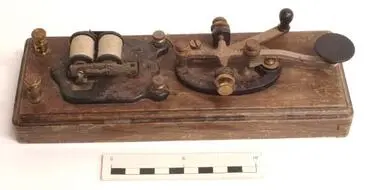
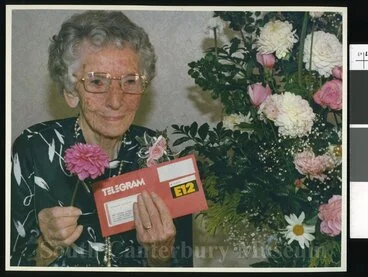
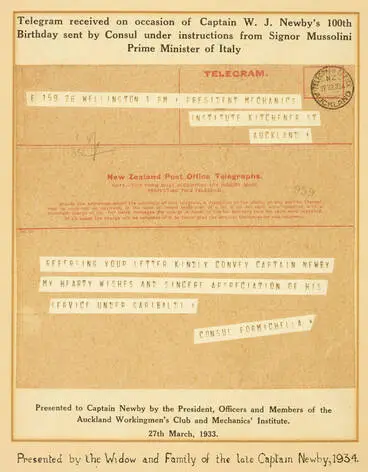
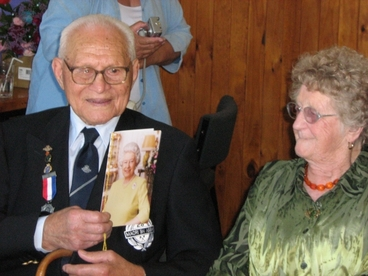

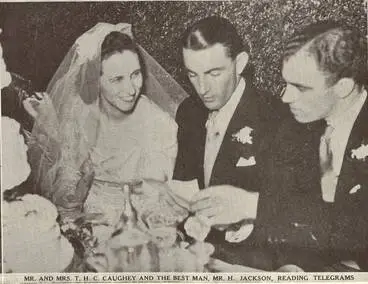
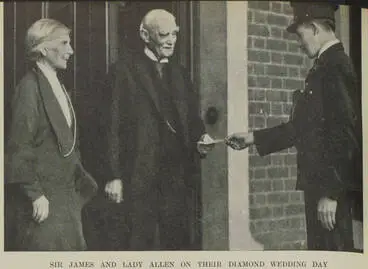
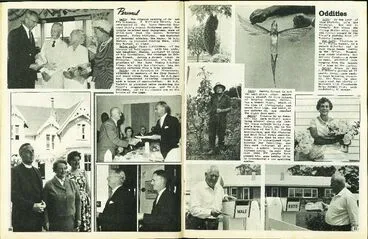




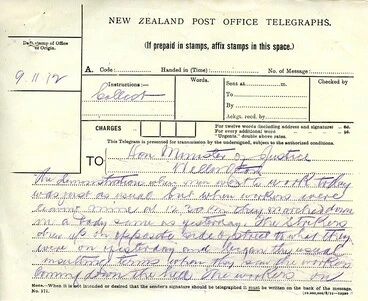


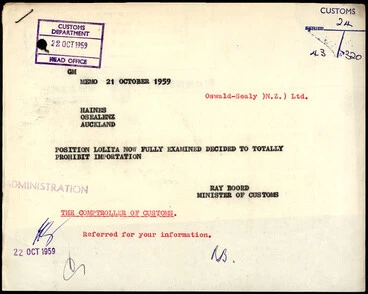

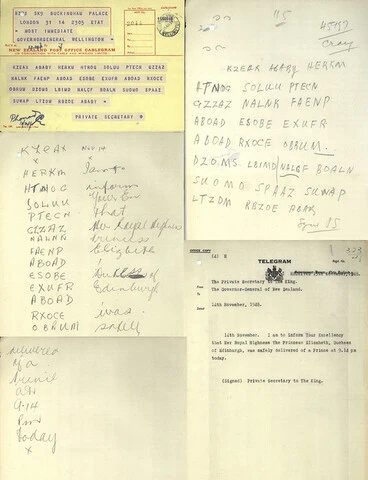
![[Receiving news of Boer War] Image: [Receiving news of Boer War]](https://thumbnailer.digitalnz.org/?resize=770x&src=https%3A%2F%2Fs3.amazonaws.com%2Fpastperfectonline%2Fimages%2Fmuseum_58%2F108%2F2681.jpg&resize=368%253E)




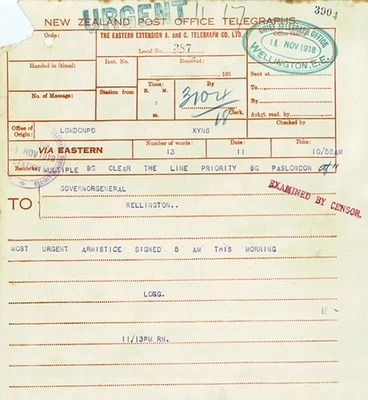


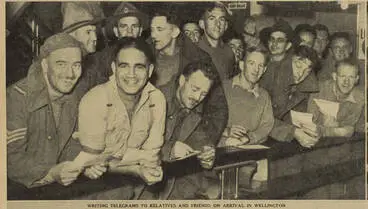

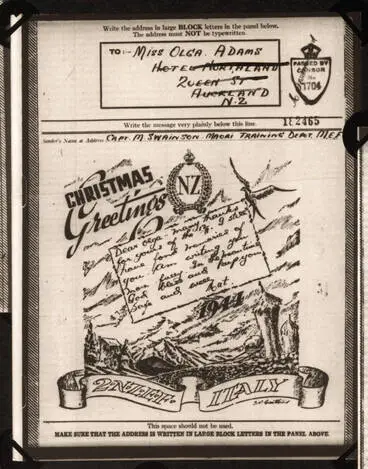
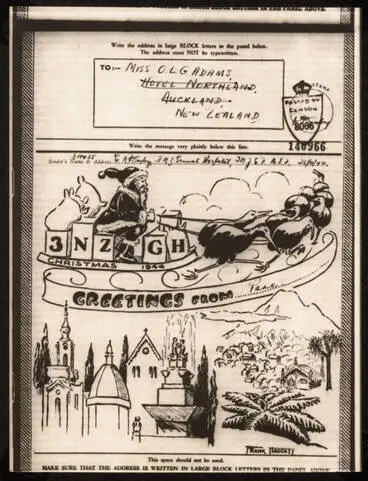
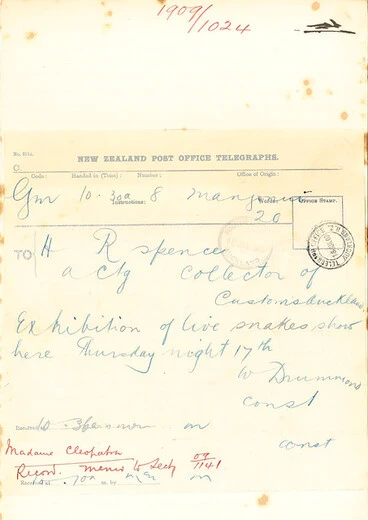
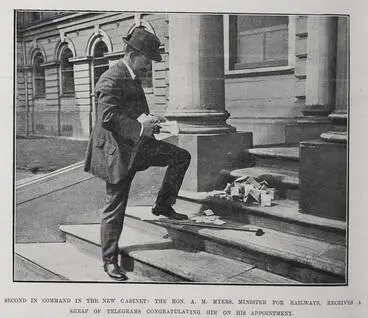
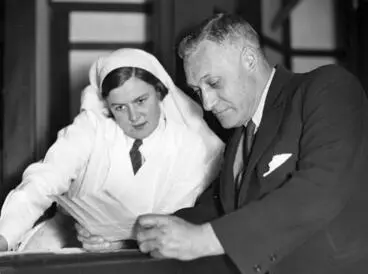





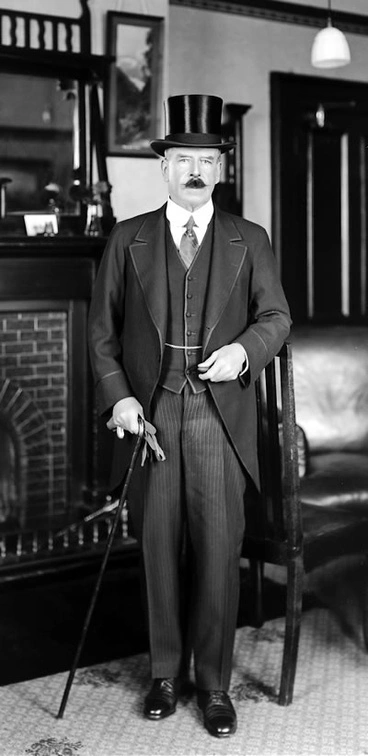



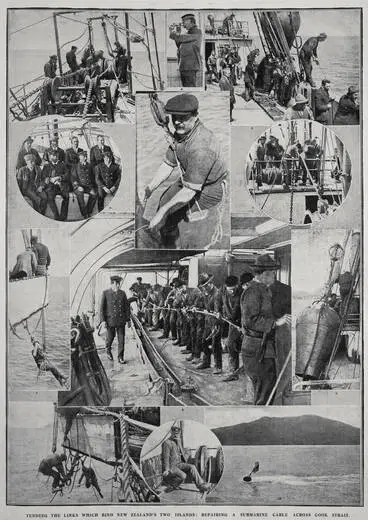
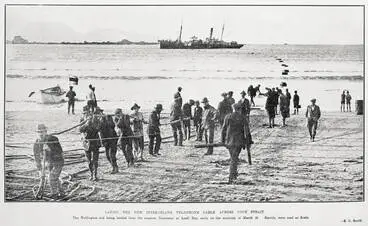
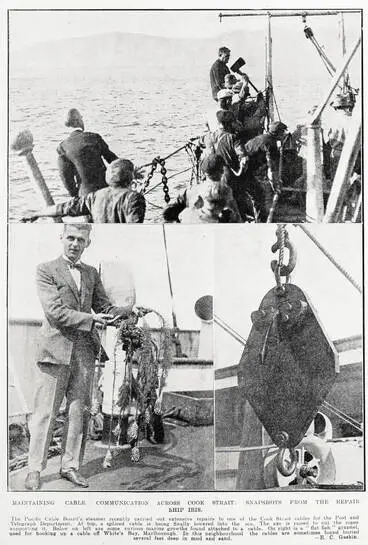
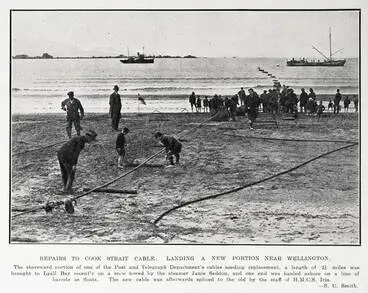
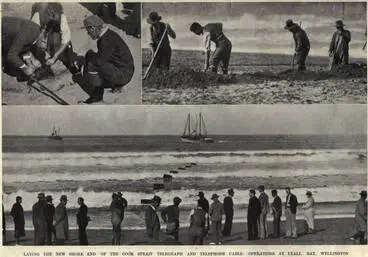


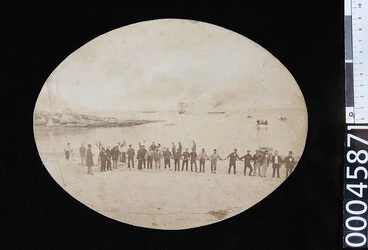
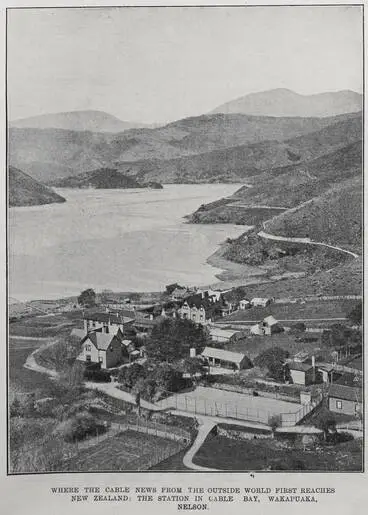
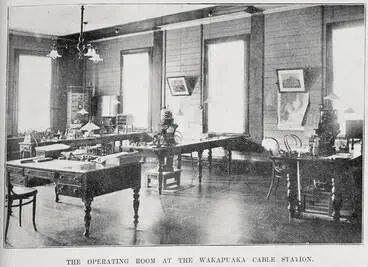
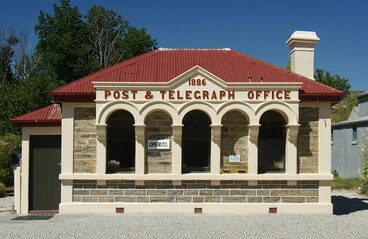
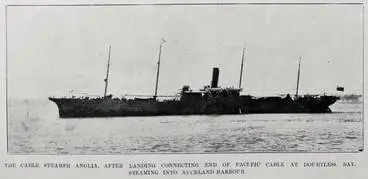
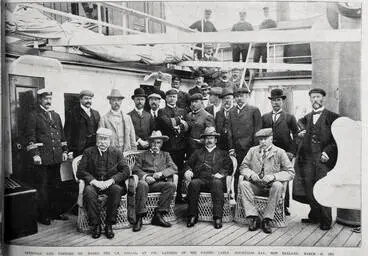




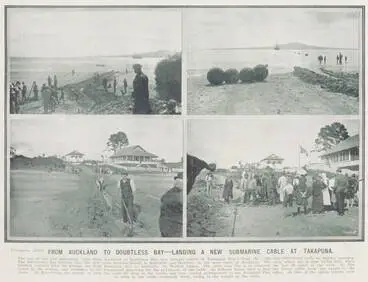

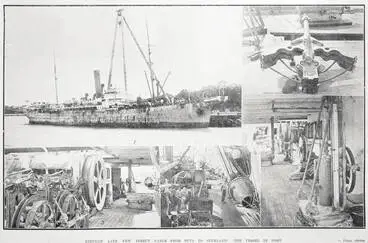
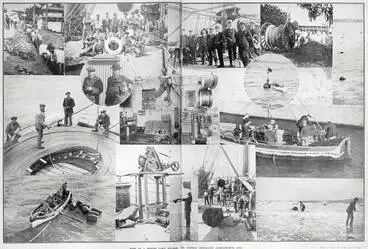



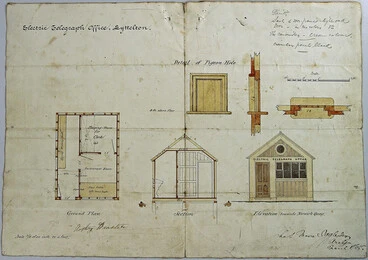
![[Timaru Post Office with timeball] Image: [Timaru Post Office with timeball]](https://thumbnailer.digitalnz.org/?resize=770x&src=https%3A%2F%2Fs3.amazonaws.com%2Fpastperfectonline%2Fimages%2Fmuseum_58%2F101%2F2651.jpg&resize=368%253E)
![[Whangarei Post and Telegraph Office] Image: [Whangarei Post and Telegraph Office]](https://thumbnailer.digitalnz.org/?resize=770x&src=https%3A%2F%2Fcollection-api.aucklandmuseum.com%2Frecords%2Fimages%2Fmedium%2F543106%2F29726fe82128ec27f59add2c8ac32b5d4dc2e8f2.jpg&resize=368%253E)
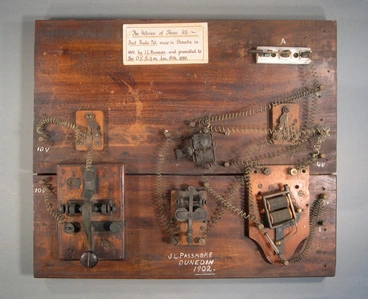


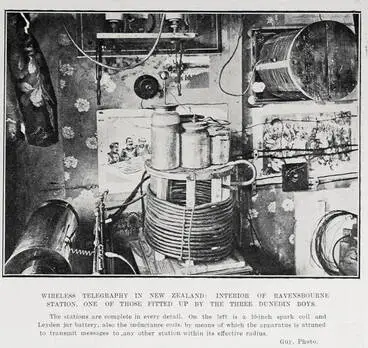

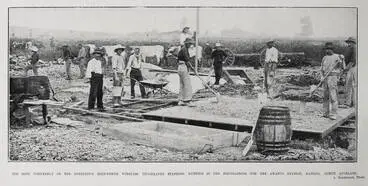
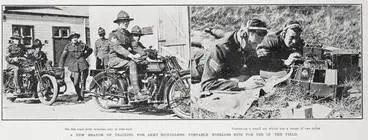

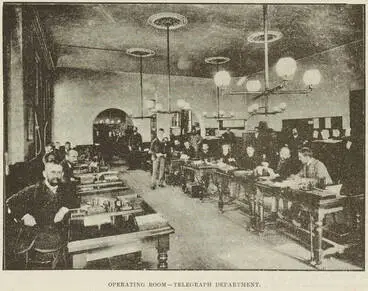
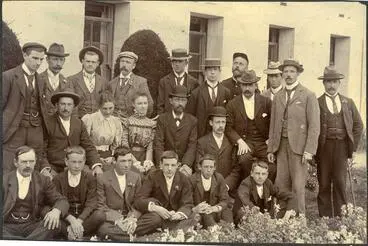

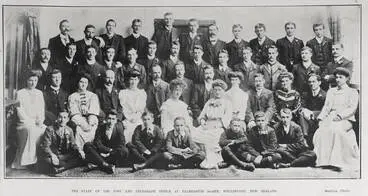
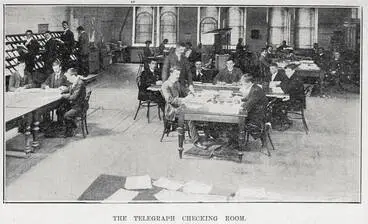
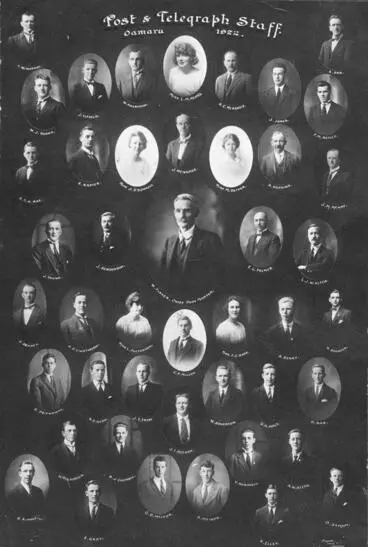
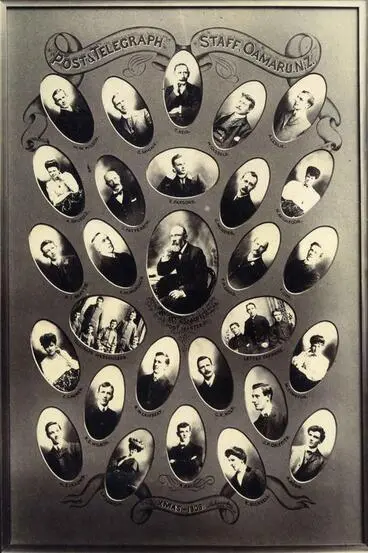
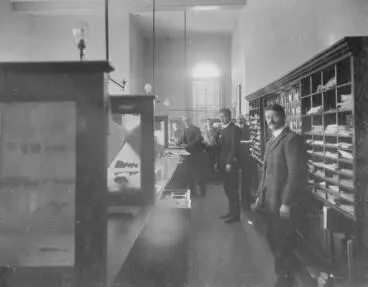

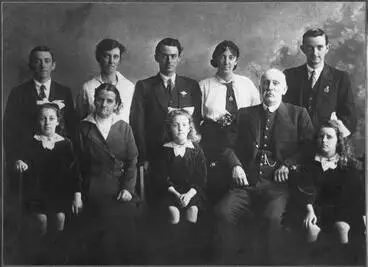
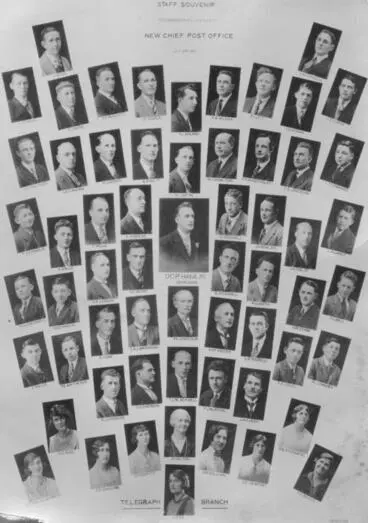




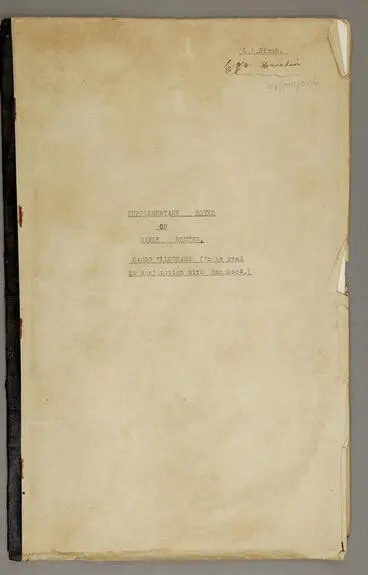

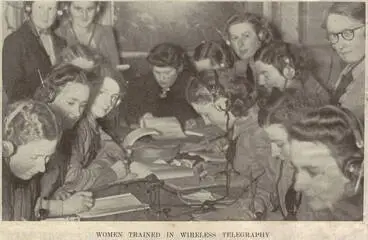
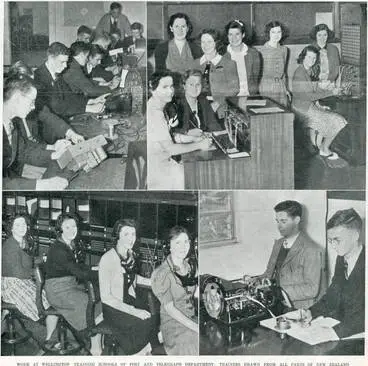
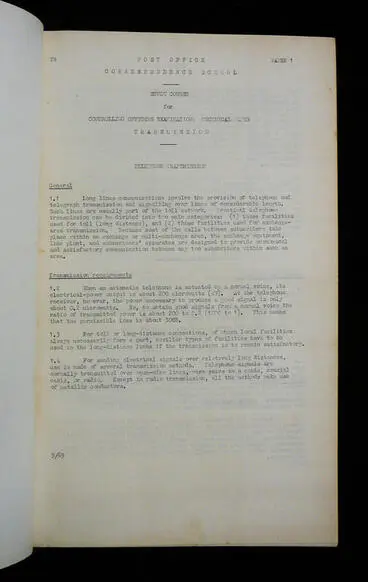

![Photograph [Men and Boys outside Mataura Post Office] Image: Photograph [Men and Boys outside Mataura Post Office]](https://thumbnailer.digitalnz.org/?resize=770x&src=https%3A%2F%2Fimages.ehive.com%2Faccounts%2F4033%2Fobjects%2Fimages%2Fud7ras_1tvr_l.jpg&resize=368%253E)
